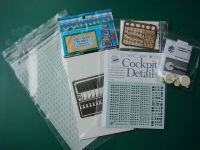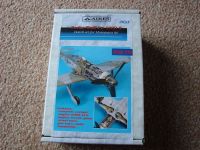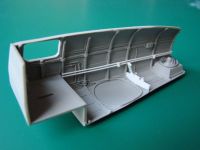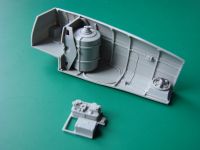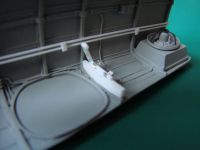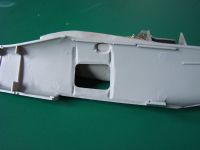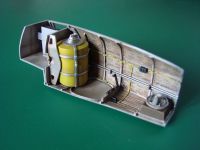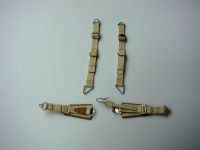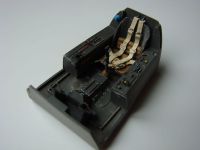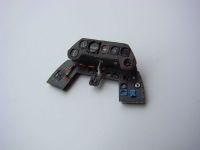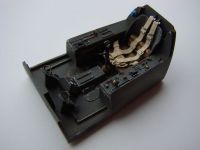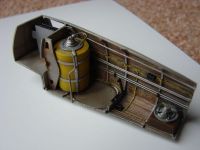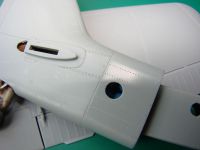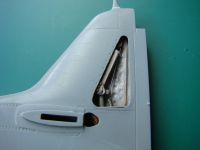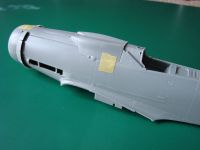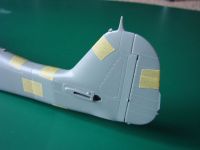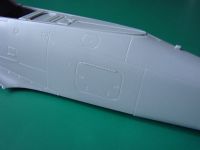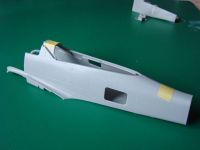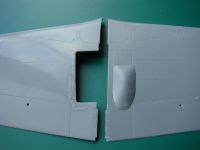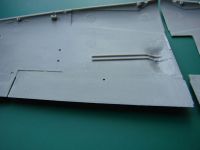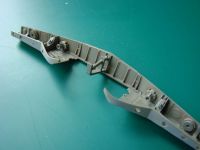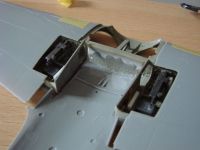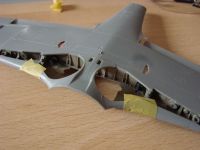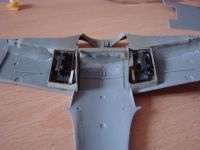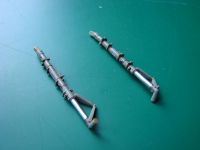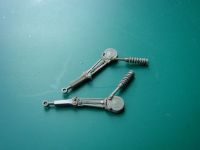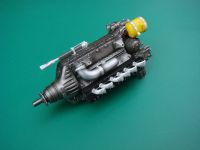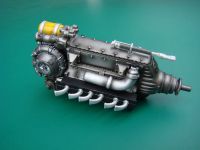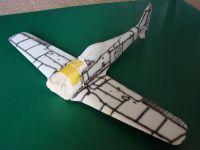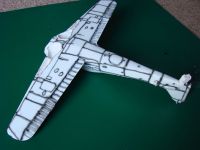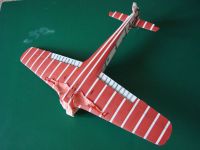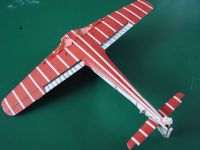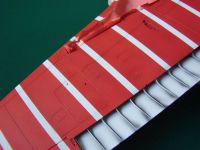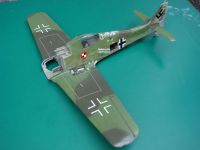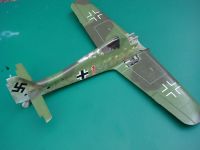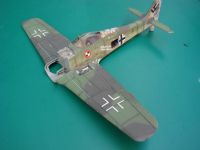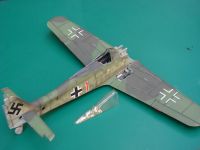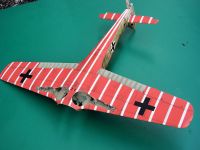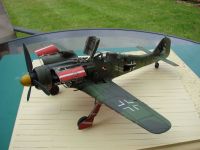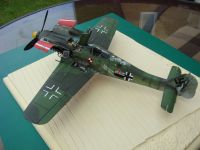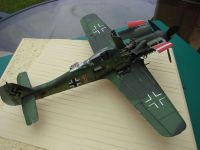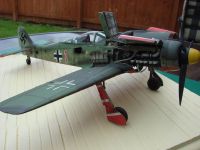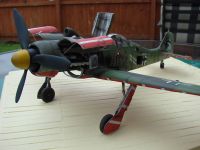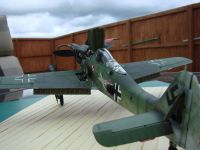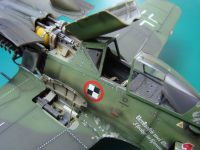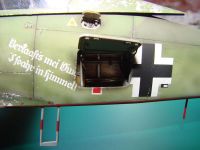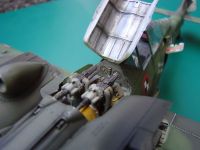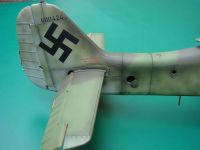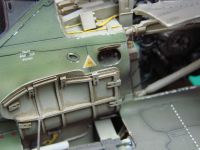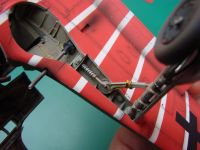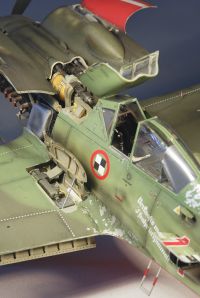Hasegawa 1/32 Focke-Wulf Fw 190D-9 with Aires ‘Full Detail Set’
By James Hatch
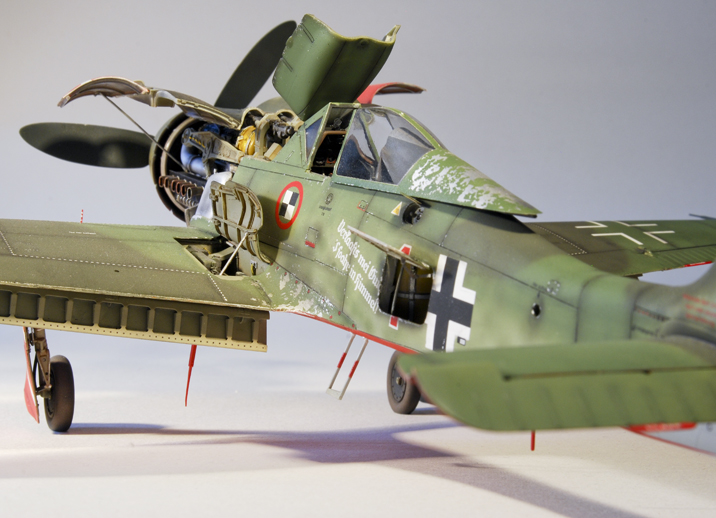
Introduction
I think the first time I ever saw a model airplane with all of its cowls and access ports open was in a Verlinden magazine, over 20 years ago and I always jokingly promised myself I would build one some day. I doubted that I would ever build one though as I had no experience of scratchbuilding, and resin kits seemed to be of another world and way too expensive to risk ruining. It wasn't long after that that I stopped working on plastic models altogether until this last couple of years when my interest was rekindled. I've always had a love of the "Langnasen" Fw 190D and was going to build her "out of box" until I saw all the incredible aftermarket materials available and my online searches showed the "open cowls" models I had wanted to build years earlier. So it just had to be done, or at least "tried" bearing in mind my inexperience.
About the Dora
The "D" variant of the Fw 190 was powered by the powerful Jumo 213 inline engine, as opposed to the radial BMW 801. This increased the overall length of the fighter which needed to be offset by the addition of a fuselage lengthening section in order to re-establish the fighters centre of gravity. The result was the sleek looking Dora that is the subject of this build. Despite the pilots initial reservations over flying a machine which basically was a fighter powered by a bomber engine, and being told by the designer Kurt Tank that this was a temporary measure until the Ta 152 production, it wasn't long before the Dora was soon taken to the hearts of those who flew it. It was an incredibly responsive fighter, having its control linkages made from pushrods instead of the more traditional metal cables which had a tendency to create "lag" in control as they stretched slightly.
The Dora was already becoming a very successful airplane in its own right before it was to become the machine of choice for the newly formed Jagdverband Jv44 unit. Jv44 was a unit comprised of a number of Dora veterans and pilots with notoriety such as Adolf Galland, its aim being to protect the newly introduced Me 262 jet fighters on their take-offs and landings. The slow nature of the 262's take off was caused by the Jumo engine being susceptible to catching fire if pushed too hard after it was started. The protection 190Ds were assigned to patrol over the airfield at low level during these vulnerable times in order to stave off attacks by roaming Allied fighters which were already claiming high numbers of the new jet wonder machines. The new protection machines were given a distinctive red and white striped underside which would be so obvious to German antiaircraft gunners as not to make them accidental targets. The unit was given the nickname "Die Würger-Staffel" but this colourful and very unusual scheme gave rise to Jv44's unofficial post-war nickname as the Papagei Staffel (Parrot Squadron).
My Project
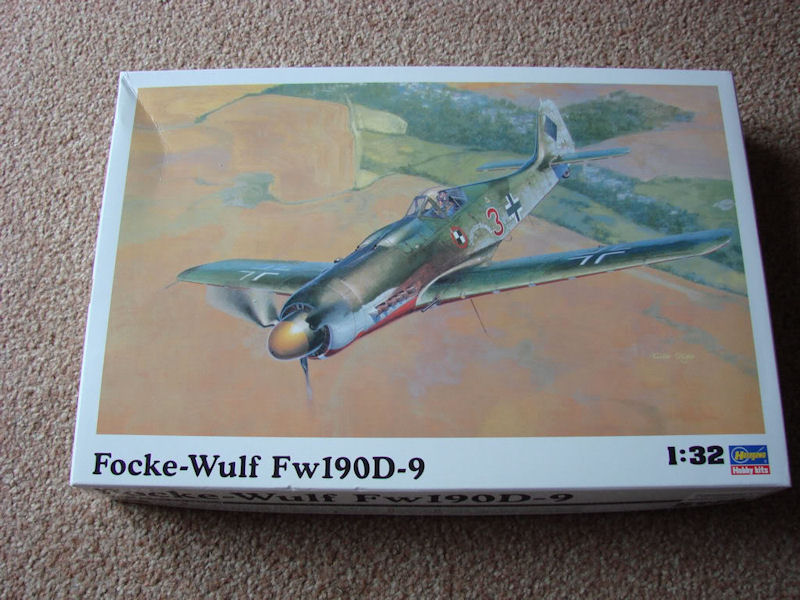
As I was going to plunge into the deep end with this model and go on a "sink or swim" mission, I spent a lot of time finding as much aftermarket material as I could for this model. I used the Hasegawa 1/32 Fw 190D-9 (new tool) for the basic kit, and also bought the Aires Full Detail set #2031 as the main detailing base too. I managed to source resin sets from relatively unknown companies and some beautiful photoetch from a one-man operation in Hungary. My favourite "extras" company "Model Design Construction" (MDC) was also a big player in items for this kit. A summary of what was bought is here:
- Aires Fw190D full detail resin set #2031
- Black Dog Focke Wulf Fw 190 D-9 resin Tail wheel with mechanism access door #A32002
- Black Dog Focke-Wulf FW 190 A,D resin detail set (flaps, rudder and fuel fillers etc) #A32001
- Eduard Fw190D Landing flaps #32101
- MDC Fw 190D9 Wheel Set #CV32028
- MDC MG-151 set with brass barrels
- Master Model MG-131 brass barrels
- Radu Brinzan Late Luftwaffe seatbelts #RB-P32006
- PK Tinyland German service panel set
- MDC German Duralumin Manufacturers Stamps #D32009
- Mike Grant Decals Instruments & Placards set
- HobbyDecal Fw-190 Stencils ver 1 #st32003v1
- Montex Super Mask Set Fw-190D9 (Galland Circus) #K 32048
- EagleCals Fw190 decal set
- G-Factor brass Fw190A/D undercarriage
Bashing the fuselage
The first thing I felt I had to do before expending any time on the various detail kits was to cut up the Hasegawa Dora kit, according to the various instruction sheets bundled with the detail sets. First off was the nose, forward of the fuselage gun section, and the fuselage and tail access ports; fuel fillers and oxygen tank ports. I kept the fuselage portion of the wing machine-gun doors in situ at this point to as not to weaken the already fragile wing roots, post nose removal. The first piece of resin to be handled was the fuselage rear interior. For this, the main fuselage access port interior was thinned rather crudely as I had no curved blades at that time. The other ports on the fuselage were also thinned. The resin interior was assembled and primed, then sprayed with Alclad Duralumin. German Duralumin manufacturer decals from MDC were applied to the aircraft skin then sealed with Klear. All shading was done with Tamiya acrylics thinned 90%. To cement the parts, I used Superglue Gel. I added the elevator and rudder push rods to the resin too. Difficult to see why Aires left these off! The engine starter crank was scratch-made from plastic-rod and tin metal and added to a raised bulkhead I built.
The cockpit was stunning and seemed to fit pretty well dry into the fuselage. All the cockpit interior sprayed with Gunze RLM66 paint and detail work was with Vallejo acrylics. Some extra detail was added to the instrument panel, and some bundles of yellow electrical wiring to the foot well. The instrument hood was also replaced with the Aires resin part. I tried some painting techniques from the new FAQ book by JM Villalba interspersed with what I knew I was already capable of. I think the resin set by Aires was possibly made for the old tooling of the Hasegawa kit as the resin rear decking behind the pilot was short by just over 3mm. There was no physical way it could have worked with this kit, so I stuck to the plastic part which was no less detailed. The cockpit walls had canopy slide runners added with plasticard also...something else missing from the Aires kit. Overall, I was pretty pleased with the results. I added a set of Luftwaffe seatbelts by Radu Brinzan also. I am absolutely amazed with them. Three hours to assemble for me, but they are exquisite, and totally adjustable to the model being built! MIG's European Dirt pigment was used to dirty up the cockpit tub around the floor area.
All fuselage assembly was done with CA so as to ease any join lines. CA was also used as a filler where appropriate, being finished with small amounts of Mr. Dissolved Putty.
Hasegawa's wonderful kit though, does not contain any rivet detail. I quite like subtle rivet detail, and the Dora's rivets could be quite obvious, so I used a Radu Brinzan Rivet-R tool to create these, using masking tape and Dymo tape as guides. For rivet data, I used Arthur Bentleys excellent series of Fw 190D-9 drawings available to order online.
The tail section had its control surfaces also removed, along with the access hatch and the Black Dog resin sets were used here. A little extra detailing within the tail to produce the dimpled interior, was also made from drilled plasticard and tin foil. The oxygen tanks in the fuselage extension section were made from children’s coloured beads strung onto plastic-rod and painted the appropriate colour. You can only just about see these when completed. The Horizontal surfaces were only dry fitted until the model had got its eventual coat of paint.
On The Wing
The wings required a lot of remedial work to make the resin and etch parts fit inside, but first they were riveted whilst being easy to handle. With the Aires resin wheel well-built and painted, and the gun bays built, careful alignment was needed to make sure these would fit inside the wing without causing the wing to bulge over it's upper skin. Constant checking against the fuselage section was needed in order to stave off disaster. All internal parts were fitted with CA then filleted with Devcon epoxy for strength. The upper wings needed to have their moulded closed gun blisters removed also. This required a little extrapolation of the panel lines under the bulge, then chain drilling out of the bay. Any remnants of the upper blister were then shaved and sanded down to the level of the wing and missing panel lines scribed onto the surface. At this point too, the part of the gun bay door on the fuselage was also removed.
Some Mike Grant ALPS printed decals were used on the interiors of the gun bays too to represent manufacturer plates. A little dirt was added to the bays and undercarriage wells by using MIG European Dirt pigment.
The Eduard etch metal flaps were also installed at this stage. These are definitely fun to assemble and look great when installed, though some serious plastic thinning is required to add them. The kit already had an option for lowered landing flaps and had plastic detail but it was nowhere as good as this. All construction was done with the 5 speed Hold 'n Fold, and glued with CA gel.
Struts and props
I figured early on that the extra weight of this model would need some serious support. After consideration, I opted for the very nice looking G-Factor undercarriage legs. The extra expense was money well spent as they are gorgeous. The casting is simply wonderful. I added a hydraulic line down each side with copper wire. After a coat of Alclad primer, I sprayed these in Gunze RLM02 and sprayed a little heavily thinned brown around the differing sections, and a burnt umber oil wash. The compression strut was then painted Vallejo Black and the whole leg given a coat of Klear. EagleCal decals were used for the Werk Nummer plates on the legs, then another sealing coat of Klear applied. The now shiny black compression strut was then airbrushed with Alclad Chrome and they came out real well. After masking the Chrome off, the whole leg was matted down with Xtracolour XDFF flat varnish thinned 50:50 with white spirit.
The actuator leg was altered to add the various resin components, and the main spring was added with lead wire. The cabling on the upper section was also made with 0.2mm lead wire, clipped in with tin metal foil. These were then painted and washed with oils.
The resin engine assembly was quite simple and to it I added some extra piping and cabling.
Let Us Spray
After carefully attaching the fuselage to the wing and eliminating any joins with a mixture of CA gel and Mr. Dissolved putty, the model was given a coat of Halfords white acrylic primer. This is a change from my usual Alclad use as I feel Alclad is too absorbent. The primer was then rubbed down with Micromesh and pre-shaded with Tamiya Black thinned 50:50 with X20A. Next up was to fade out the underside with Tamiya flat white, before masking off with Tamiya tape strips 1/8" wide. Gunze RLM23 red was then sprayed underneath and the model given its distinctive candy-stripe look. Next up was to mask the completed underside and fuselage was then sprayed with RLM65 more or less up the full height of the fuselage. The model was given it's coat of Gunze RLM82 Light Green in the appropriate areas whilst controlling the paint to ensure the pre-shading was still visible. RLM83 was then sprayed free hand. I didn't spray overall one colour then add the other on top as I figure this would give a false representation of the RLM83.
The next task sent chills down my spine....the mottling. I had never done this before, and if I'm really honest, this had been worrying me since I first took the project on. After some kind advice of a fellow online modeller (cheers Dave Pratt!) I thinned my paint mix down to 10% paint to thinner ratio, but didn't bother with the advice of practice first as I am far too impatient. I blasted the thinned paint over the model in small bursts as different distances and different pressures using my Iwata HPC+ with its new MAC valve. The mottle was done with both RLM82 & 83 and made heavier as it reached the top area of the fuselage with its regular camo. This did seem to blend it in quite well. At this point, I quit for the day while I was ahead!!
I gave the model 3 coats of Klear before adding the wonderful EagleCals decals set. I opted to build "Red 1", flown by Heinz "Heino" Sachsenberg at the outset of the project due to several physical differences in this particular build (no FuG antennae or lifting hole plates attached). The decals were added using Mr Mark Setter, then the decals sealed with Klear again.
Where I perhaps felt the pre-shading had suffered from over paint, or I had forgotten to properly emphasize the panels, I sprayed heavily thinned Tamiya Black finely, at high pressure, using a sheet of paper to catch the main part of the jet and leave just a fine edge on the model.
The model was then given a coat of Xtracolor XDFF flat varnish to give it's 'in service' look. The transformation was quite unbelievable for a novice like me.
The engine was given a coat of Alclad Magnesium, but afterwards, it just didn't seem right despite me loving the colour, so I toned it down with Alclad Dark Aluminium. The engine was given a coat of Alclad Steel, and the associated pipework and tubed were sprayed with Alclad Aluminium. The finished assembly was then highlighted with a heavily thinned coat of Tamiya Black around bolt heads and recesses etc in order to create some depth. Afterwards, the whole lot was washed in heavily thinned Black oil paint, except for some of the pipework which I still wished to remain semi shiny. Engine bearers were painted RLM02, and wiring in yellow. Other detail work on the bulkhead area was also painted; yellow for electrical wiring etc, and then washed in burnt umber oils.
The badly paint chipped canopy which was specific to Sachsenbergs 190D was created by spraying the piece with Alclad Duralumin, then using a sponge to apply Abteilung Liquid Mask. When this was set, the canopy was sprayed with its appropriate camo colour, then the rubber mask removed by rubbing away with a finger. The same also applies to the wing root where the pilot would dismount from his machine.
Final Assembly and Paint
The engine was now mounted to the fuselage, and here is where a problem was encountered. Despite everything being checked against my Arthur Bentley technical drawings, the engine had a downward attitude when mounted, and it was quite obvious. There was nothing more I could do than to pack the lower bearer struts out by about 1mm. This had the desired effect on I was back on track. The bulkhead wiring was now added and the undercarriage legs placed. I used MDC resin wheels for this with the flexible resin brake hoses. The wheels were painted in Tamiya black, sprayed in Satin varnish and then thin brown paint sprayed around the tyres and some pigment added.
Landing flaps and the horizontal tail sections now added, as well as the resin rudder. The resin cowls were now painted in their appropriate colours, with the interiors being sprayed in Alclad Duralumin. Again, MDC Duralumin stamp decals were used, and the panels shaded with thinned black to create shadow. At this point, I also tried some of my new Alclad Hot Metal Sepia in random patches to simulate the effects of heat within the cowls. The cowls and radiator ring were now fitted.
The propeller was from kit. The spinner was first painted white and a spiral added from a Montex Mask kit, then the whole lot sprayed black. Afterwards, the newly painted spinner was sprayed in a distempered yellow as to simulate the real machine which had a different colour spinner earlier in its service history. The spiral can just be seen through the yellow finish. The prop was then added.
Small finishing details were now added, such as the crew step, pitot etc, and the model was completed.
Final Thoughts
Overall, I think I achieved what I set out to do, with some surprises for myself, especially with regard to the mottling. I know I could have improved upon things if I was to do this again, but this model is a learning curve, so I am more than happy with the result. Eventually, this model will be displayed sat upon a resin hardstand diorama, with some figures and accessories.
The Hasegawa kit and Aires resin sets are exceptional, as are many of the items I bought for this. I seem to have been born with Advanced Modellers Syndrome, but I think that's part of the fun for me. I've been in contact with many helpful people while researching this build, and laid the way for my future modelling.
I did what I wanted to do since I was young, so now that the pressure is off, I can take things a little more leisurely. Or can I?
© James Hatch 2011
This article was published on Friday, November 18 2011; Last modified on Friday, June 02 2017

